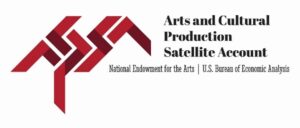 Updated Creative Economy State Profiles are now available, with information that describes the value of arts and cultural production along with job and compensation data in every state in 2023.
Updated Creative Economy State Profiles are now available, with information that describes the value of arts and cultural production along with job and compensation data in every state in 2023.
These data, published by the U.S. Bureau of Economic Analysis (BEA) in partnership with the National Endowment for the Arts (NEA), are a trusted source for measuring the value of the creative economy.
In 2023, arts and cultural production accounted for:
Building on the substantial recovery observed in 2021 and continued strength in 2022, the 2023 data suggest that the U.S. arts and cultural sector grew at more than twice the rate of the broader economy in the postpandemic landscape. Using inflation-adjusted numbers, the U.S. arts economy grew over 6.6%, while the economy as a whole grew around 2.9%. Research shows that the creative sector can drive broader state economic growth.
By 2023, arts employment had firmly rebounded from pandemic lows, though with notable variations across industries. Following the strong overall gains of 2021-2022, growth moderated in 2023, with total arts employment reaching nearly 5.4 million wage-and-salary jobs—a modest 0.3% increase (16,422 positions) over 2022. The recovery revealed distinct patterns: Performing arts industries (including independent artists, writers and performers) continued their upward trajectory but slowed from 28% growth in 2022 to 8% in 2023. Meanwhile, arts related retail reversed its earlier 7% decline with a 3% gain in 2023. Not all sectors participated equally in the recovery. Motion picture industries and sound recording, which each grew by about 21% in 2022, experienced sharp declines of 14% in 2023. Similarly, computer systems design surged by 40% from 2021 to 2022 but slowed significantly, posting only a 5% increase in 2023.
These shifts suggest the arts sector has moved from a dramatic postpandemic rebound into a more nuanced phase of stabilization, marked by a mix of continued growth, moderation and adjustment across different industries. (Note: The BEA’s Arts and Cultural Production Satellite Account (ACPSA) employment data include only wage-and-salary jobs and exclude self-employed artists and cultural workers, so the actual size of the creative workforce is even larger.)
NASAA’s Creative Economy State Profiles help to make data from the BEA’s Arts and Cultural Production Satellite Account more accessible and engaging. Produced in cooperation with the NEA, this interactive dashboard provides information in a visual format to describe the creative economy in every state.
Your state’s creative economy story is unique, and this tool allows you to explore and share that story with key decision makers. Use the Creative Economy State Profiles to understand:
Designed to complement the NEA’s suite of ACPSA resources, this interactive dashboard is one of many tools to help state arts agencies and arts advocates understand and communicate accurate data about your state’s creative economy.
Please view and explore the Creative Economy State Profiles, and don’t hesitate to contact me for help using this information in your state.
Mohja Rhoads
Research Director